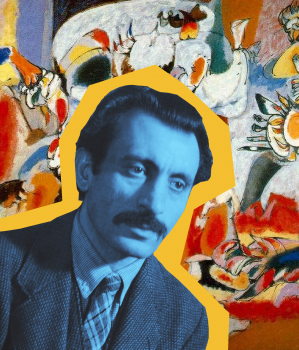Profile | Arshile Gorky
April 15, 1904 - July 21, 1948
ProfileFew artists have been able to transcend ethnocultural borders and earn worldwide name recognition: Arshile Gorky is among them. A key founder of abstract expressionist art, Gorky (born Vosdanig Manoug Adoyan) was a prolific painter whose tragic personal life influenced and elevated his art to uncharted heights. A survivor of the Armenian Genocide, he sought safety and peace in the United States, achieving the former but not the latter, tragically taking his own life at the height of his prowess. As contemporary British art critic William Feaver stated, Gorky’s death left the field open for his now more-famous rival, Jackson Pollock. Despite his early departure, Gorky’s artistic legacy lives on today, with many of his paintings and drawings hanging in the world’s most prestigious museums and galleries
An Armenian-American painter
Looking at Gorky’s art and reflecting on his life story, one cannot help but wonder: was he a born genius, destined for greatness, or did a series of heartbreaking circumstances turn an otherwise ordinary man into an extraordinary talent? It’s a question we will never know the answer to, but we can try to piece together the transformation from Vosdanig, the farm boy from Khorgom to Arshile, the internationally-renowned American artist.
Born in a little village outside of Van to a reconstituted family who lost many loved ones in the Hamidian Massacres of 1894-96, Vosdanig father left for America early on to escape the Ottoman military draft. With his mother and sisters, young Vosdanig spent his days roaming around the fields of his idyllic land. Many of his paintings later in life were directly inspired by the scenery of his adolescence. When the Genocide began, his family fled east, to what became the Republic of Armenia. Meeting the fate of hundreds of thousands of genocide refugees at that time, his mother succumbed to hunger and died in his arms. Vosdanig, just a teenager, never recovered from the trauma (see The Artist and His Mother).
After relocating to America, he set out to recreate his identity, settling on the name “Arshile Gorky” and a background story that would evolve so constantly over the years, even he couldn’t keep up. Though he changed the most intimate features of himself—countries, cultures, names, age, and artistic styles—Gorky could never shake the darkness that hovered over him like a hidden tumor, chipping away at his soul; at about 44 years of age, he hanged himself outside his New England home.
I don’t like that word, 'finish.' When something is finished, that means it’s dead, doesn’t it? I believe in everlastingness. I never finish a painting—I just stop working on it for a while.
-Arshile Gorky, 1948
Character, spirit and style
The most defining event in Gorky’s life was the loss of his mother. Precipitated by the Genocide and loss of his ancestral land and childhood Eden, it is no wonder that many of Gorky’s pieces have an underlying theme of pain and loss. Several paintings also draw inspiration from the serene nature around him—from the farms of Khorgom to the quiet rolling hills of Virginia.
Influences and contributions
Gorky’s artistic style went through many iterations, beginning with the French Post-Impressionists, like Paul Cezanne, while an art student in Boston in the early 1920s. After moving to NYC in 1925, he was introduced, and greatly drawn, to the surrealism of Joan Miro and emerging cubism of Pablo Picasso—particularly his synthetic cubism. As one of the key founders of the abstract expressionism movement, Gorky has left an indelible mark on all those who came after him.
Achievements
- Many scholars hail him as the ‘last Surrealist painter’ and the ‘first Abstract Expressionist,’ with a seminal influence on developing the latter movement
- Gorky’s paintings hang in every major American museum, including the National Gallery of Art in Washington DC, the Art Institute of Chicago, and New York’s Metropolitan Museum of Art, the Museum of Modern Art, and the Whitney Museum of American Art.
- In 2005, his family established the Arshile Gorky Foundation, a not-for-profit corporation to further the public’s appreciation and understanding of the artist.
Interesting facts
- According to his wife, Agnes Magruder, Gorky’s mother wanted her son to be a poet and he felt she had given him a mission to carry out.
- His chosen first name, Arshile, is derived from the Greek tragic hero of the Iliad, Achilles, and his surname, Gorky, is taken from Russian writer Maxim Gorky, whose real name was Alexei Peshkov. A pseudonym based on another pseudonym—talk about confusing! (For another example of this, check out Soviet Armenian writer Paruyr Sevak, who adopted his surname after Ottoman Armenian poet Rupen Sevag, whose real name was not Sevag at all, but Chilingirian.)
- Perhaps not an interesting fact about the artist himself, but certainly about his legacy: in 2013, a famous tennis player’s brawl with a gallery owner to buy Gorky’s Pirate I and Pirate II paintings led to some serious back-and-forth disputes in court.
Awards and recognition
- In Nov. 2017, Gorky’s granddaughter and President of the Arshile Gorky Foundation, Saskia Spender, curated "Ardent Nature: Arshile Gorky Landscapes, 1943-47." Held in the New York branch of the art gallery, Hauser & Wirth, the exhibit was the first in the city exclusively dedicated to the artist’s mature works.
- The Republic of Armenia’s Minister of Diaspora awards an “Arshile Gorky” medal to those who help make Armenian art more recognizable in the diaspora or achieve success as painters.
"I met a lot of artists — but then I met Gorky... He had an extraordinary gift for hitting the nail on the head; remarkable. So I immediately attached myself to him and we became very good friends. It was nice to be foreigners meeting in some new place.
- Willem De Kooning



Attention!